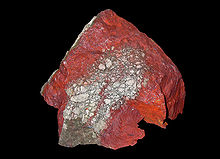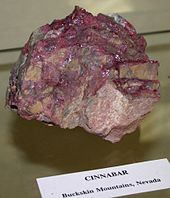- Cinnabar
-
This article is about the mineral. For the plant resin, see Dragon's blood. For the moth, see Cinnabar moth.
Cinnabar 
Cinnabar on DolomiteGeneral Category Sulfide mineral Chemical formula mercury(II) sulfide, HgS Strunz classification 02.CD.15a Crystal symmetry Trigonal Trapezohedral
H-M symbol: 3 2
Space group: P31 2 1Unit cell a = 4.145(2) Å, c = 9.496(2) Å, Z=3 Identification Color Cochineal-red, towards brownish red and lead-gray Crystal habit Rhombohedral to tabular; granular to massive and as incrustations Crystal system Trigonal Twinning Simple contact twins, twin plane {0001} Cleavage Prismatic {1010}, perfect Fracture Uneven to subconchoidal Tenacity Slightly sectile Mohs scale hardness 2-2.5 Luster Adamantine to dull Streak Scarlet Diaphaneity Transparent in thin pieces Specific gravity 8.176 Optical properties Uniaxial (+) Refractive index nω = 2.905 nε = 3.256 Birefringence δ = 0.351 Solubility 1.04 x 10-25 g per 100 ml water (Ksp at 25°C = 2 x 10-32)[1] References [2][3][4] Cinnabar (pronounced /ˈsɪnəbɑr/) or cinnabarite (/sɪnəˈbɑraɪt/) (red mercury(II) sulfide (HgS), native vermilion), is the common ore of mercury.
Contents
Word origin
The name comes from κινναβαρι (kinnabari), a Greek word most likely applied by Theophrastus to several distinct substances. Other sources say the word comes from the Persian شنگرف shangarf (زینجیفرح zinjifrah), a word of uncertain origin (also compare, Sanskrit: sugara). In Latin it was sometimes known as minium, meaning also "red lead", though both of these terms now refer specifically to lead tetroxide.
Structure
HgS adopts two structures, i.e. it is dimorphous.[5] The more stable form is cinnabar, which has a structure akin to that for HgO: each Hg center has two short Hg-S bonds (2.36 Å), and four longer Hg---S contacts (3.10, 3.10, 3.30, 3.30 Å). The black form of HgS has the zincblende structure.
Properties
Cinnabar is generally found in a massive, granular or earthy form and is bright scarlet to brick-red in color.[6] It occasionally occurs in crystals with a non-metallic adamantine luster. Cinnabar has a rhombohedral bravais lattice, and belongs to the hexagonal crystal system, trigonal division. Its crystals grow usually in a massive habit, though they are sometimes twinned. The twinning in cinnabar is distinctive and forms a penetration twin that is ridged with six ridges surrounding the point of a pyramid. It could be thought of as two scalahedral crystals grown together with one crystal going the opposite way of the other crystal. The hardness of cinnabar is 2–2.5, and its specific gravity 8.1.
Cinnabar resembles quartz in its symmetry and certain of its optical characteristics. Like quartz, it exhibits birefringence. It has the highest refractive power of any mineral. Its mean index for sodium light is 3.08,[7] whereas the index for diamond is 2.42 and that for gallium (III) arsenide (GaAs) is 3.93.
Occurrence
Generally cinnabar occurs as a vein-filling mineral associated with recent volcanic activity and alkaline hot springs. Cinnabar is deposited by epithermal ascending aqueous solutions (those near surface and not too hot) far removed from their igneous source.
It is associated with native mercury, stibnite, realgar, pyrite, marcasite, opal, quartz, chalcedony, dolomite, calcite and barite.[2]
Cinnabar is found in all localities that yield mercury, notably Puerto Princesa (Philippines); Almadén (Spain); New Almaden (California); Hastings Mine and St. John's Mine, Vallejo, California;[8] Idrija (Slovenia); New Idria (California); Giza, Egypt; Landsberg, near Obermoschel in the Palatinate; Ripa, at the foot of the Apuan Alps and in the Mount Amiata (Tuscany); the mountain Avala (Serbia); Huancavelica (Peru); Murfreesboro, Arkansas; Terlingua (Texas); and the province of Guizhou in China, where fine crystals have been obtained. It was also mined near Red Devil, Alaska on the middle Kuskokwim River. Red Devil was named after the Red Devil cinnabar mine, a primary source of mercury.
Cinnabar is still being deposited at the present day from the hot waters of Sulphur Bank Mine in California and Steamboat Springs, Nevada.
Mining and extraction of mercury
Cinnabar has been mined since the Neolithic Age (Martín-Gil et al.). During the Roman Empire it was mined both as a pigment (Vitruvius, DA VII; IV-V) (Pliny, HN; XXXIII, XXXVI-XLII) and for its mercury content (Pliny HN; XXXIII, XLI), and it has been the main source of mercury throughout the centuries.
To produce liquid (quicksilver) mercury, crushed cinnabar ore is roasted in rotary furnaces. Pure mercury separates from sulfur in this process and easily evaporates. A condensing column is used to collect the liquid metal, which is most often shipped in iron flasks.
Toxicity
Because of its mercury content, cinnabar can be toxic to human beings. Though ancient peoples in South America often used cinnabar for art, or processed it into refined mercury (as a means to gild silver and gold to objects) "the toxic properties of mercury were well known. It was dangerous to those who mined and processed cinnabar, it caused shaking, loss of sense, and death...data suggest that mercury was retorted from cinnabar and the workers were exposed to the toxic mercury fumes."[9] Overexposure to mercury, mercurialism, was seen as an occupational disease to the ancient Romans, "Mining in the Spanish cinnabar mines of Almaden, 225 km southwest of Madrid, was regarded as being akin to a death sentence due to the shortened life expectancy of the miners, who were slaves or convicts."[10]
Cinnabar turned into a fine powder is often referred to as vermilion which can be used as a food coloring in extremely small amounts. Animal testing has shown vermilion "proved fatal to animals in the proportion of from thirty to seventy grains, even when applied externally to a wound."[11]
Decorative use
Cinnabar has been used for its color in the new world since the Olmec culture.[12] Cinnabar was often used in royal burial chambers during the peak of Mayan civilization.[13]
The most popularly known use of cinnabar is in Chinese carved lacquerware, a technique that apparently originated in the Song Dynasty. The danger of mercury poisoning may be reduced in ancient lacquerware by entraining the powdered pigment in lacquer,[14] but could still pose an environmental hazard if the pieces were accidentally destroyed. In the modern jewelry industry, the toxic pigment is replaced by a resin-based polymer that approximates the appearance of pigmented lacquer.
Other forms of cinnabar
- Hepatic cinnabar is an impure variety from the mines of Idrija in the Carniola region of Slovenia, in which the cinnabar is mixed with bituminous and earthy matter.
- Metacinnabarite is a black-colored form of HgS, which crystallizes in the cubic form.
- Synthetic cinnabar is produced by treatment of Hg(II) salts with hydrogen sulfide to precipitate black, synthetic metacinnabarite, which is then heated in water. This conversion is promoted by the presence of sodium sulfide.[15]
- Hypercinnabar, crystallise in the hexagonal form.
See also
- China red
- Classification of minerals
- List of minerals
References
- ^ Meyers, J. (1986). Chem. Ed. 63: pp. 689.
- ^ a b Mineral Handbook
- ^ Mindat
- ^ Webmineral
- ^ Wells, A.F. (1984). Structural Inorganic Chemistry, Oxford: Clarendon Press. ISBN 0-19-855370-6.
- ^ King, R. J. (2002). "Minerals explained 37: Cinnabar". Geology Today 18 (5): 195–199. doi:10.1046/j.0266-6979.2003.00366.x.
- ^ Schumann, Walter (1997). Gemstones of the World. New York: Sterling. ISBN 0806994614.
- ^ C.Michael Hogan, Marc Papineau et al., Environmental Assessment of the columbus Parkway Widening between Ascot Parkway and the Northgate Development, Vallejo, Earth Metrics Inc. Report 7853, California State Clearinghouse, Sept, 1989
- ^ Georg Petersen G. (2010). Mining and metallurgy in ancient Perú. The Geological Society of America.
- ^ Andrew Wallace Hayes (2008). Principles and methods of toxicology. New York, NY: Informa Healthcare USA, Inc..
- ^ Alfred Swaine Taylor (1849). Medical jurisprudence. London, England: Wilson and Ogilvy.
- ^ New World's Oldest, in Time Magazine, Monday, Jul. 29, 1957
- ^ Cinnabar-covered ruin.
- ^ http://www.cst.cmich.edu/users/dietr1rv/cinnabar.htm R. V. Dietrich, 2005
- ^ Holleman, A. F.; Wiberg, E. "Inorganic Chemistry" Academic Press: San Diego, 2001. ISBN 0-12-352651-5.
Other references
- Martín-Gil, J; Martín-Gil, FJ; Delibes-de-Castro, G; Zapatero-Magdaleno, P; Sarabia-Herrero, FJ (1995). The first use of vermillion. Cellular and Molecular Life Sciences, 51(8):759-761
External links
Ores Acanthite (silver) · Chalcopyrite (copper) · Chalcocite (copper) · Cinnabar (mercury) · Galena (lead) · Pentlandite (nickel) · Sphalerite (zinc)OtherOre deposit types Banded iron formation · Carbonate hosted lead zinc ore deposits · Heavy mineral sands · Iron oxide copper gold · Kambalda type komatiitic nickel ore deposits · Lateritic nickel · Magmatic nickel-copper-iron-PGE deposits · Porphyry copper · Sedimentary exhalative deposits · Volcanogenic massive sulfideCategories:- Sulfide minerals
- Mercury minerals
- Trigonal minerals
- Traditional Chinese medicine
- Alchemical substances
- Poisonous minerals
Wikimedia Foundation. 2010.


